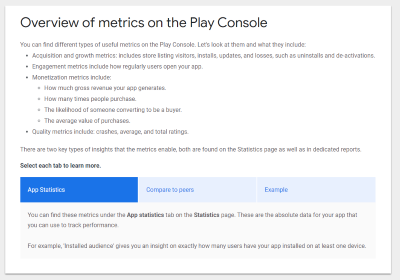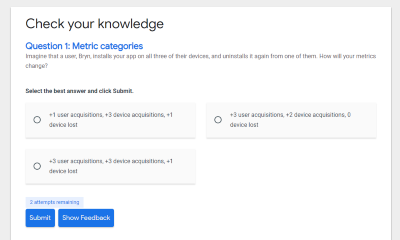
A brief review of the (free) Google Play Store Listing Certificate as a developer
Back in December, I got an email about something called the “Google Play Store Listing Certificate”. It seemed pretty relevant to my job, and I finally got round to completing it! It’s mostly targeted towards digital marketers, but it has value for engineers publishing on the store, so here’s a short unbiased review.
You can read an overview of the certificate on the official site, essentially it’s a free qualification intended to help digital marketers get into working with the Google Play Store. Here’s my certificate, it can also be added to LinkedIn!
The certificate process
The process was straight forward, with it taking 2-3 hours from first deciding to complete the certificate to finishing the exam. Here’s what’s involved:
- Work through the ~13 sections of the study guide, each taking between 5 and 10 minutes.
- Register for an account on WebAssessor.
- Complete the timed exam of ~60 multiple choice questions.
- Receive an immediate pass / fail, with a certificate being emailed to you within a day or so.
The study guide content
All of the study guide’s content is available without registering, and it’s essentially a structured summary of the key points from Google’s Developer Policy Center.
It’s very readable and well written, with plenty of interactive elements (tabs, expandable areas, fictional conversations etc) to keep the content engaging. Let’s use the painfully dry sounding “Track installs, uninstalls, and trends with Play Console statistics” section as an example.
The learning material starts with an overview of why these metrics matter, what you’ll be learning in this section, and how to actually use Google Play Console. Simple techniques like hiding parts of information behind a tabbed interface forces the reader to actively engage, instead of just passively scrolling through a wall of text:
The next part of the page, as with many other Google training resources, features simple artwork that complements dull descriptions, and makes the information easier to parse. Each image requires interacting with to display the description, again encouraging the reader to be actively involved in the learning process:
This technique of hiding content behind very intuitive interactions continues throughout, with expandable question & answer sections, fictional conversations, and clickmapped screenshots. This mixture of different interactions and a visually appealing interface really does make the learning process easier, it’s evident that significant invisible work has gone into the resource.
I’ve skipped over a few sections of this page, but the above examples should be plenty to get a feel for the information’s ease of access. Finally, the reader is informally quizzed on two simple questions that are well crafted to be easy if the content has been engaged with, and impossible otherwise:
Overall, the material was excellently laid out, and I genuinely wish more online training resources took notes. Techniques like breaking the page up into smaller, easily digestible segments with a variety of visual elements are effective enough that I’m intending to change my own documentation style as a result!
Despite spending perhaps 90-120 minutes reading through all the content, it didn’t feel onerous or challenging, and the microinteractions were pleasing enough to motivate continuation. As someone who reads a lot of fiction & non-fiction, I can recognise excellent writing even if I can’t write it myself yet!
However, I do want to point out that the content is not going to change your outlook on life or solve any app-related problems you’re encountering. If you already publish Android apps, or market them, you’ll likely know 70-80% of the content already. As someone who used to handle the entire publishing process I’d estimate I knew around 90% of the content, with the unknown aspects being those a mobile SEO expert would likely already know, e.g. custom store listings, analytics, tracking users.
The exam
The exam was… honestly too easy. I’m not trying to show off when I say that, honest!
You have 5 hours to complete 60 multiple questions, and can open new tabs or Google questions as much as you like. Most of the questions are evidently written after looking at the learning material, with all of them being directly answerable by finding the relevant page in the study guide. You can come back to questions later, and there’s no microphone / webcam requirement, or any identity verification.
That being said, the exam certificate in general is obviously intended to get people reading the content, so it absolutely succeeds in its’ goal. It isn’t meant to be a formal qualification, so the laxer difficulty and requirements make sense.
Once you’ve completed your exam, you can submit your details to be included in a global directory of Google Play Store Listing Certificate holders. I unfortunately encountered an issue here where I couldn’t fill in the form, as it’s the same form used for the Associate Android Developer Certificate I acquired a few years ago! This is unlikely to be true for most people though, and to be honest I’m yet to see any benefit from this global directory.
Review
The Google Play Store Listing Certificate is an excellent free resource, and I really hope it’s the first of many similar certificates. The overall style reminded me of the Google Codelabs (very high quality introductions to technical topics), but non-technical topics are often relegated to a collection of help articles.
Whilst gamification of learning obviously has pros and cons, simple elements such as progress bars, checkboxes, and a certificate at the end really increases the motivation and satisfaction in learning. I would absolutely not have spent a couple of hours reading information on Google Play listings, but adding some kind of reward at the end made me do it happily, and now spend time recommending it to others!
In conclusion, if you’re a developer / marketer / product owner working with the Google Play store, this is a really good use of your time. It’ll help refresh some topics, and probably clarify a few misconceptions that everyone picks up when learning things on the job.
It’s free, and no registration is needed to look at the resources. And no, this wasn’t a sponsored post!



